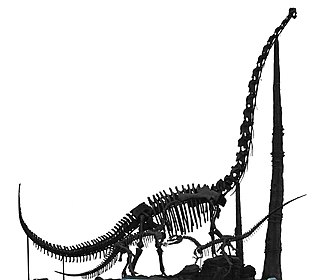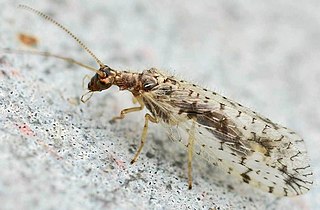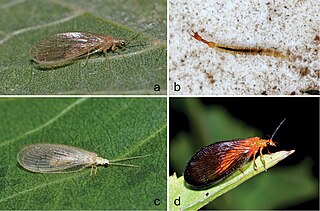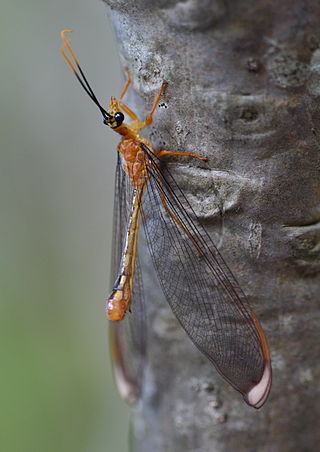
The insect order Neuroptera, or net-winged insects, includes the lacewings, mantisflies, antlions, and their relatives. The order consists of some 6,000 species. Neuroptera is grouped together with the Megaloptera and Raphidioptera (snakeflies) in the unranked taxon Neuropterida.

Scarabaeoidea is a superfamily of beetles, the only subgroup of the infraorder Scarabaeiformia. Around 35,000 species are placed in this superfamily and some 200 new species are described each year. Its constituent families are also undergoing revision presently, and the family list below is only preliminary. This superfamily includes some of the largest beetles extant today, including rhinoceros beetles, (Dynastinae), the Hercules beetle and Goliath beetles.

Green lacewings are insects in the large family Chrysopidae of the order Neuroptera. There are about 85 genera and 1,300–2,000 species in this widespread group. Members of the genera Chrysopa and Chrysoperla are very common in North America and Europe; they are very similar and many of their species have been moved from one genus to the other time and again, and in the nonscientific literature assignment to Chrysopa and Chrysoperla can rarely be relied upon. Since they are the most familiar neuropterans to many people, they are often simply called "lacewings". Since most of the diversity of Neuroptera are properly referred to as some sort of "lacewing", common lacewings is preferable.

Snakeflies are a group of predatory insects comprising the order Raphidioptera with two extant families: Raphidiidae and Inocelliidae, consisting of roughly 260 species. In the past, the group had a much wider distribution than it does now; snakeflies are found in temperate regions worldwide but are absent from the tropics and the Southern Hemisphere. Recognisable representatives of the group first appeared during the Early Jurassic. They are a relict group, having reached their apex of diversity during the Cretaceous before undergoing substantial decline.

Chuanjiesaurus is a genus of sauropod dinosaurs from the middle Jurassic Period. They lived in what is now China. The type species, Chuanjiesaurus anaensis, was first described by Fang, Pang, Lü, Zhang, Pan, Wang, Li and Cheng in 2000. Fossils of the species were found in the village of Chuanjie, Lufeng County, Yunnan Province, and are named after the location where the fossils were discovered. Holtz gave a length of 25 meters.

Mantispidae, known commonly as mantidflies, mantispids, mantid lacewings, mantisflies or mantis-flies, is a family of small to moderate-sized insects in the order Neuroptera. There are many genera with around 400 species worldwide, especially in the tropics and subtropics. Only five species of Mantispa occur in Europe. As their names suggest, members of the group possess raptorial forelimbs similar to those of the praying mantis, a case of convergent evolution.

Osmylidae are a small family of winged insects of the net-winged insect order Neuroptera. The osmylids, also called lance lacewings, stream lacewings or giant lacewings, are found all over the world except North and Central America. There are around 225 extant species.

Hemerobiidae is a family of Neuropteran insects commonly known as brown lacewings, comprising about 500 species in 28 genera. Most are yellow to dark brown, but some species are green. They are small; most have forewings 4–10 mm long. These insects differ from the somewhat similar Chrysopidae not only by the usual coloring but also by the wing venation: hemerobiids differ from chrysopids in having numerous long veins and forked costal cross veins. Some genera are widespread, but most are restricted to a single biogeographical realm. Some species have reduced wings to the degree that they are flightless. Imagines (adults) of subfamily Drepanepteryginae mimic dead leaves. Hemerobiid larvae are usually less hairy than chrysopid larvae.

The Perissommatidae are a family of flies (Diptera) that was proposed in 1962 by Donald Colless based on the species Perissomma fusca from Australia. The family now includes five extant species within the single genus Perissomma, four from Australia and one from Chile. The Perissommatidae are unusual as they appear to have four compound eyes. They have a small slender body less than 2 mm in length. Their wings are large in comparison to their bodies and subsequently their flight is weak. Preferring high-altitude forest environments, adults only fly in the winter. The larvae live in decaying leaf litter in wet sclerophyll or cool rain forests. Some species are suspected to be associated with fungi. In the case of Perissomma macalpinei, numbers of adults have been observed congregating in clumps of foliage and rising in short, zigzag flights in the sunlight above the foliage for short periods before descending.

The Nevrorthidae are a small family of lacewings in the order Neuroptera. There are 19 extant species in four genera, with a geographically disjunct distribution: Nevrorthus, comprising 5 species with scattered distributions around the Mediterranean; Austroneurorthus, with two species known from southeastern Australia; Nipponeurorthus, comprising 11 species known from China and Japan; and Sinoneurorthus, known from a single species described from Yunnan Province, China. They are traditionally placed in the Osmyloidea, alongside Osmylidae and the spongillaflies (Sisyridae), but some research has considered them to be the sister group to the rest of Neuroptera. The larvae have unique straight jaws that are curved at the tips, and live as unspecialised predators in the sandy bottom sediments of clear, fast flowing mountain rivers and streams. They pupate underwater on the underside of stones. The adults are likely predators or feed on honeydew and other sugar-rich fluids.

Nymphidae, sometimes called split-footed lacewings, are a family of winged insects of the order Neuroptera. There are 35 extant species native to Australia and New Guinea.

Psychopsidae is a family of winged insects of the order Neuroptera. They are commonly called silky lacewings.

Ithonidae, commonly called moth lacewings and giant lacewings, is a small family of winged insects of the insect order Neuroptera. The family contains a total of ten living genera, and over a dozen extinct genera described from fossils. The modern Ithonids have a notably disjunct distribution, while the extinct genera had a more global range. The family is considered one of the most primitive living neuropteran families. The family has been expanded twice, first to include the genus Rapisma, formerly placed in the monotypic family Rapismatidae, and then in 2010 to include the genera that had been placed into the family Polystoechotidae. Both Rapismatidae and Polystoechotidae have been shown to nest into Ithonidae sensu lato. The larvae of ithonids are grub-like, subterranean and likely phytophagous.
Leptolingia is an extinct genus of lacewing insect, which existed in what is now China during the Middle Jurassic period. It contains the species L. jurassica, L. tianyiensis, L. calonervis, and L. imminuta. L. imminuta is the smallest known species in the family Grammolingiidae.
Grammolingiidae is an extinct family of lacewing insect which existed in what is now China during the Middle Jurassic period.

Kalligrammatidae, sometimes known as kalligrammatids or kalligrammatid lacewings, is a family of extinct insects in the order Neuroptera (lacewings) that contains twenty genera and a number of species. The family lived from the Middle Jurassic to the early Late Cretaceous before going extinct. Species of the family are known from Europe, Asia, and South America. The family has been occasionally described as "butterflies of the Jurassic" based on their resemblance to modern butterflies in morphology and ecological niche.
This list of fossil arthropods described in 2011 is a list of new taxa of trilobites, fossil insects, crustaceans, arachnids and other fossil arthropods of every kind that have been described during the year 2011. The list only includes taxa at the level of genus or species.

Heloridae is a family of wasps in the order Hymenoptera known primarily from fossils, and only one extant genus, Helorus, with 12 species found worldwide. Members of Helorus are parasitic on green lacewings.
2015 in paleoentomology is a list of new fossil insect taxa that were described during the year 2015, as well as other significant discoveries and events related to paleoentomology that were scheduled to occur during the year.
Vetosmylus is an extinct genus of lance lacewing from the Middle Jurassic. Both species were described from the Jiulongshan Formation near Daohugou Village, China, which dates back to the Aalenian–Bajocian boundary. It bears close resemblance to extant genera, particularly Parosmylus. The well-preserved female genitalia of V. maculosus are extremely similar to that of Parosmylus. Vetosmylus is the oldest member of the subfamily Osmylinae thus far known, significantly extending its temporal range. No unambiguous representatives exist between Vetosmylus and an Osmyline from the Eocene-aged Florissant formation, suggesting there is a heretofore unknown ghost lineage in between.














